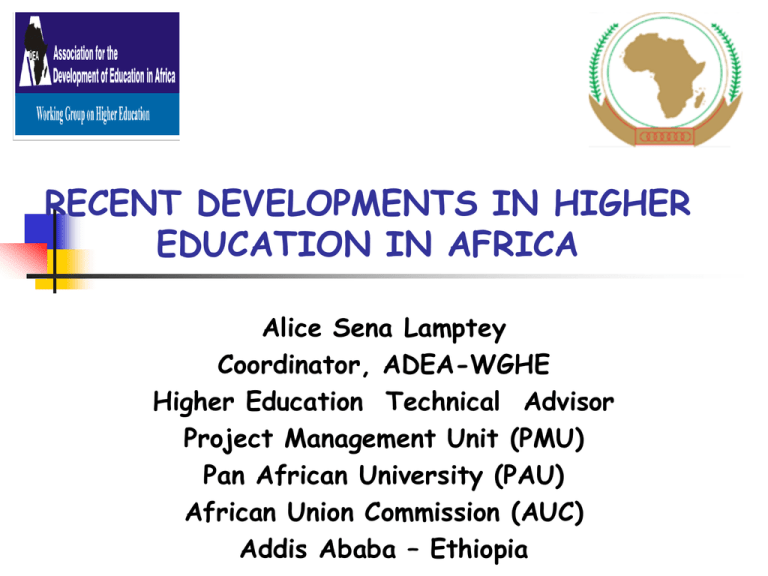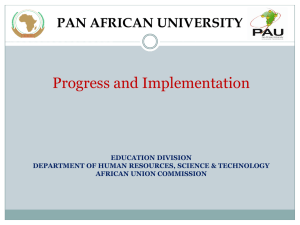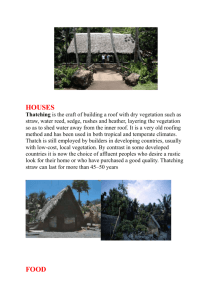adea working group on higher education
advertisement

RECENT DEVELOPMENTS IN HIGHER EDUCATION IN AFRICA Alice Sena Lamptey Coordinator, ADEA-WGHE Higher Education Technical Advisor Project Management Unit (PMU) Pan African University (PAU) African Union Commission (AUC) Addis Ababa – Ethiopia OUTLINE TWO MAJOR (2) LANDMARKS -2006 Continental Policy Framework -UNESCO 2009 World Conference on H E HISTORY AND CHARACTERISTICS OF AHE KEY CONCERNS OF STAKEHOLDERS AU PRIORITY HIGHER EDUCATION PROGRAMS -Arusha Convention -Pan African University CONCLUDING REMARKS A BITABOUT ADEA POLICY FRAMEWORK The African Union’s Vision for the continent: Peaceful prosperous integrated Africa…….. 2006 COMEDAF adopted a 2nd Decade of Education for Africa, with a Plan of Action (PoA) Higher education one of 8 priorities and 4 thematic areas of focus under H E: - Research and knowledge production - Quality assurance - Role and contribution of H E to improving other levels of education - Financing HISTORY (1) Africa once was the cradle of civilization (Al Ahzar Univ. in Cairo 1st Century; Karawyyin Fez – 1st Century; Univ. of Timbuktu 13th Century; Fourah Bay College ) 1950 and 60s African H E institutions had solid reputation as centers of excellence comparable to the best globally 1980s economic crisis, structural adjustment policies and misguidance of the WB gave priority to basic education HISTORY (2) Resources dwindled, resulting in deterioration in quality in all its forms 1990–2000 saw series of institutional reforms 2006 revitalization begun with political strong leadership from the AU with support from partners including ADEA and UNESCO 2009 WCHE+10 set specific goals and targets 2011 Mid-term evaluation of 2nd Decade PoA 2012 call for a paradigm shift for Africa to focus on science technology and innovation, youth empowerment, entrepreneurial skills for self employment and public-private-partnerships (PPP) CHARACTERISTICS (1) Disparate systems from colonial heritage (Anglophone, Francophone, Lusophone, Arab-Europe) Mostly university-based Mostly state-funded Expanding non-university sub-sector Rapidly expanding private sector and offshore providers Massive increases in access yet gross enrolment ratio estimated at a mere 7% compared to world average of 25% Low students’ participation CHARACTERISTICS (2) Lack of differentiation and opportunities for life-long learning Weak linkage with productive sector Mismatch between graduate outputs and labor market needs Graduates lack entrepreneurial skills Weak public-private-partnership (PPP) Questions of quality and global competitiveness Key CONCERNS (1) Africa’s contribution to global research turnover 1.1% in 2010 Africa has the lowest number of patents globally, and Nobel Prize awards Lowest female representation particularly in Science and Technology and maths An acute shortage of high-caliber and research-strong academics largely due to brain drain and brain circulation KEY CONCERNS (2) Not enough countries have or are implementing STI policies and plans Questions of curriculum relevance Outmoded training approaches Africa’s youth bonus forms 40% of working population out of which 60% are unemployed, under-employed or unemployable and this is a time bomb if countries don’t take urgent steps !! POSITIVE TRENDS Increasing awareness that knowledge, not natural resources, is key to the continent’s development Increasing appreciation of the role and contribution of H E to improving quality at lower levels of education The gap between policy and financing is closing fast in some countries (Mauritius, Nigeria, Rwanda, Ghana, Tunisia etc) Increasing efforts aimed at continental harmonization (the LMD reforms) to enhance academic mobility within the continent POSITIVE TRENDS Increasing stakeholders’ demand for relevance, quality and value for money (governments, students/parents, employers) Growing awareness of the impact of internationalization & the need to be globally competitive Increasing political leadership by the African Union Growing national continental and international partnerships and drive to ensure synergy AU’s FLAGSHIP PROGRAMS The Pan African University (PAU) African Quality Rating (AQRM) Strategy for harmonisation, academic mobility and regional integration Mwalimu Nyerere and Africa-India Scholarship Programs Strategy for Teacher’s Professional Development and Teacher Mobility Science Research Grants and Awards ARUSHA CONVENTION (1) Africa’s Regional Convention for Recognition of Studies, Certification, Diplomas, Degrees and other Academic Qualification in Higher Education Africa To support the comparability and recognition of HE of programs and qualifications; facilitate mobility of academic staff and students within Africa; reinforce solidarity and integration among the State Parties; contribute to UNESCO’s efforts to promote international academic mobility. ARUSHA CONVENTION (2) Introduced 5th December 1981in Arusha Tanzania, long Before the Bologna Process, yet only 21 Countries out of 54 have ratified: Algeria, Benin, Burkina Faso, Burundi, Cote d’Ivoire, Equatorial Guinea, Egypt, Gabon, Guinea Conakry, Lesotho, Niger, Nigeria, Rwanda, Senegal, Seychelles, Sudan, Tanzania, The Holy See, Togo, Zambia ARUSHA CONVENTION (3) (Challenges) Low awareness and commitment Weak link between the 3 levels of implementation (national, sub-regional and continental) Weak link between AU’s H E Harmonization Strategy and other subregional and continental initiatives Revision has lagged behind continental and global higher education developments ARUSHA CONVENTION (Challenges) Degree of transparency and credibility of State Parties’ criteria and procedures of evaluation and recognition of degrees is not robust Fears of access of nationals Linguistic issues Quality concerns Revision process been painfully slow PAN AFRICA UNIVERSITY (PAU) (Model) New generation of African university Constituted on networking of five (5) existing flagship institutions / hubs The focus on thematic areas deemed relevant to Africa’s development Allocation was competitive and by sub-region Start date September 2012 PAN AFRICA UNIVERSITY (PAU) (Thematic Focus and Hubs) Basic Sciences Technology and Innovation (at JKUAT Kenya in Eastern Africa) Life and Earth Sciences Ibadan Nigeria in West Africa) (at University of Governance, Humanities and social sciences (at Yaoundé Cameroon in Central Africa) Water and Energy including Climate Change (Algeria) Space sciences not decided (Southern Africa) PAN AFRICA UNIVERSITY (PAU) (Justification) Africa is under-served by world-class universities focusing on post-graduate training and advanced research and innovation PAU aims to mobilize the contribution of Africa’s brightest and young including from the Diaspora As well as attract international experts PAN AFRICA UNIVERSITY (PAU) (Justification) PAU aims to accelerate academic mobility within Africa to foster regional integration PAU aims to bridge the acute gap between the aging professoriate and next generation of African academics PAU aims, through promoting quality, to promote Africa’s global competitiveness PAN AFRICA UNIVERSITY (PAU) (Mandate and Scope) PAU will train Masters and Doctoral students, provide infrastructure For world-class research and knowledge transfer to solve challenges: Each Institute will enroll 100 Masters and PhD students Each will network with up to 10 Satellite Centers Host Country that commits to provide resources Lead Thematic financial and tech. Partner (LTP) The support of its Regional Economic Community (REC) which is expected to play an active financing role PAN AFRICA UNIVERSITY (PAU) (Technical and Financial Partners) African Union Member States Regional Economic Communities (RECs) European Union (Germany, Sweden, Spain? Finland?) African Development Bank (AfDB) ADEA (Technical) UNESCO (Technical) India Japan (JICA) China Korea? PAN AFRICA UNIVERSITY (PAU) (Sustainability Concerns) Sustainable business model for PAU? How to Interface PAU with existing continental initiatives (2ie Burkina, Nelson Mandela Inst. AVU) How to establish and maintain appropriate costeffective financial controls How can appropriate technology transfer policies be developed adopted/implemented costeffectively and successfully? How a dispersed network of institutions can cost-effectively share curricula, services and resources while ensuring accountability CONCLUDING REMARKS Africa is strengthening its higher education and research space (AHERS) ADEA is spearheading the AHERS initiative with political leadership of African Union and key partners The focus is Science technology and innovation and accelerated youth empowerment The primary goals? increased access to success, equity, quality, harmonized regional integration HE research space The destination? global competitiveness THE EVIDENCE? February 2012 ADEA http://www.adeanet.org/triennale/indexang.html April 2012 STI Forum organized by major funding partners AfDB, ADEA, UNESCO, UNECA, Government of Kenya, concrete actions April 2012 COMEDAF V reviewed progress of implementation of 2nd Decade Action Plan and made concrete recommendations for actions to accelerate progress AHERS Synthesis report and recommendations presented at 2019 UNESCO WCHE+20 TRIENNIAL THEME Promoting critical knowledge, skills and qualifications for sustainable development in Africa: How to design and implement an effective response by education and training systems “Tertiary Education is another area of success for the Second Decade. There are several continental, regional, and member state initiatives that attest to this. However, more support is required from the continental level for helping to finance initiatives” Source: Page 32 Mid-Term Evaluation of 2nd Decade of Education for Africa (Draft Report) A BIT ABOUT ADEA ADEA is a network of partnerships and a forum for policy dialogue on education development in Africa. Led by African Ministers of Education and their Development Partners Founded in 1988 in Paris as “Donors to African Education” (DAE) In 1995 became the Association for the Development of Education in Africa (ADEA) with African Ministers determining the agenda Relocated in 2008 and hosted by AfDB in Tunis A BIT ABOUT ADEA cont.. ADEA’s Working Groups are its intellectual arms for analytical work, advocacy, networking and small-scale capacity building WGEMPS, TP, ECD, COMED, BLMs, NFE, Task Force on ICT and 3 ICQNs WGHE seconded to AU to support PAU implementation after WCHE+10 WGEMPS supports the African Education Observatory Currently developing new ADEA Vision and Strategy CONTACTS Alice Sena Lamptey ADEA-WGHE Coordinator Higher Education Technical Advisor (PAU-PMU) African Union Commission (AUC) P. O. Box 3243 Addis Ababa - Ethiopia Tel: + 251 115 526 373 Cell: +251 (0) 92 080 7232 Emails: a.lamptey@afdb.org lampteya@africa-union.org www.adeanet.org www.pau.org






